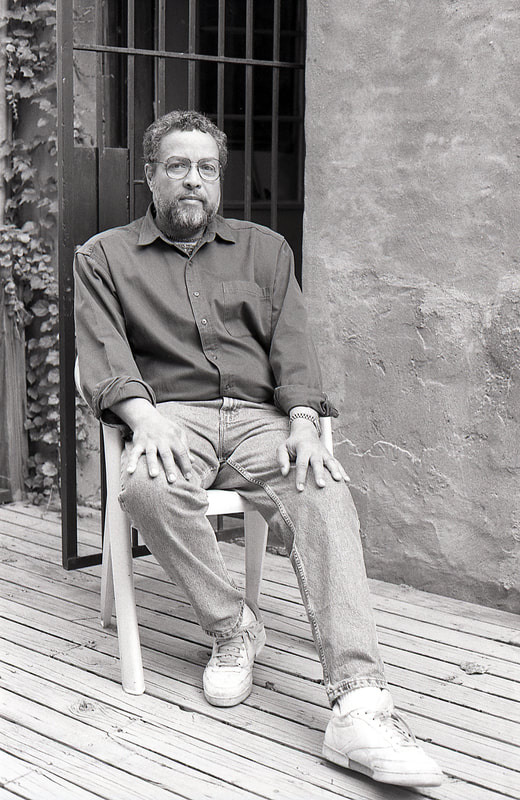|
Paul Claude Gardère (b. 1944 - d. 2011) was a Haitian and American mixed-media artist who received artistic training at The Art Student’s League of New York (’60 - 61), Cooper Union (BFA ‘67) and Hunter College (MFA ‘72). He holds the distinction of being the first Haitian Artist-in-Residence at The Studio Museum in Harlem (‘89-90), was awarded a residency at Fondation Claude Monet (’93) and received the Joan Mitchell Foundation Award for Painting in 1998, among other notable achievements. During his 40+ year career, he worked and exhibited in both the United States and Haiti, but maintained his primary residence in Brooklyn, NY.
Exhibiting vast technical and stylistic range, Gardère’s painting and mixed-media discipline realized diverse works and series, all of which investigate the phenomenology of racial and cultural relations (both conflict and syncretism) produced by Western imperialism and transnational migration in his native and adoptive countries. Drawing on history and symbology from Haitian, French, and US American cultures, Gardère’s work unites the national histories that informed his cultural experience and conveys the complex, often paradoxical multiplicities implicit in Afro-Caribbean diaspora identity and the post-colonial immigrant experience. His works simultaneously reflect his own inner tensions as well as the dynamics of power and cultural identity at play in global populations reckoning with histories of exploitation and forced acculturation to Eurocentric systems and values. During his lifetime, Paul Gardère received respected curatorial acclaim, particularly among academics and curators of Latin American and African art who grasped the thematic and symbolic references running through his work. Works of his reside in numerous institutional and university permanent collections. Despite institutional and curatorial acclaim, his career largely escaped recognition in the for-profit gallery economy of the late 20th and early 21st centuries. His sudden death in 2011 at age 66 left behind a formidable estate of un-exhibited works. He remains a lesser known American artist of Caribbean descent in the canons of Western contemporary art. |
biography |
Born in Port-au-Prince in 1944 to a well-known Haitian family surname, Paul Claude Gardère was the eldest of two sons and raised in accordance with French-speaking, Catholic customs, typical for the mulatto class in Haitian society. In 1949, Paul’s father, photographer Pierre Camille Gardère, died an early death at age 31, leaving their mother, Marcelle, with two young boys to raise on her own.
In 1957, needing to better support her sons, Marcelle accepted a position in New York City with the historic American engineering and architectural firm Tippetts, Abbott, McCarthy and Stratton which had been on location in Haiti for a dam project that failed to come to fruition. Marcelle left her boys temporarily in the care of female family elders in Haiti while she established herself in the United States. Two years later, in 1959 - as François Duvalier’s noiriste regime was becoming increasingly violent and hostile toward the mulatto class - the boys were sent for and were happily reunited with their mother. The little family lived in a basic 1-bedroom apartment in Queens, and faced the racial discrimination, xenophobia, and linguistic challenges typical for Haitian immigrants in the segregated United States pre-Civil Rights legislation. Their new American social status stood in sharp contrast to the family’s position of esteem in Haitian society – a paradox that would heavily inform Gardère’s lifelong inquiry into social, economic, and racial dynamics of power, as well as profound questions of racial and cultural identity. Academic merit earned Paul a full tuition scholarship to the Lycée Français de New York for high school, and his daily movements around Manhattan introduced him to the city's art economy. He was enthralled by the art in gallery windows of Madison Avenue and frequently found comfort in The Metropolitan Museum of Art and The Museum of Modern Art. In 1960, he enrolled at The Art Students League, where he studied under Charles Alston, the famed Harlem Renaissance painter and mentor to iconic African American artist Jacob Lawrence. Read Full Text... |
the estate |
The Estate of Paul Gardère is managed by his daughter, Catherine, to protect the artist’s remaining body of work and promote his artistic legacy. Operating publicly as Paul Gardère Studio out of the artist's original studio in Cobble Hill Brooklyn, the estate employs a mission to preserve the artist's archive and inventory, to support cultural scholarship by making his materials available for research, to encourage curatorial challenge of historically dominant and colonialist paradigms, and to enhance dialogue in and about the global Caribbean diaspora. The estate focuses its activity on archive management, exhibition facilitation, institutional acquisitions, selective private sales, and support of rising global talent and historically marginalized voices in the art world.
|
